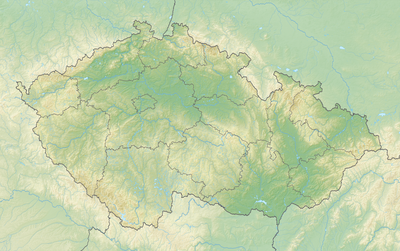Ascher Ländchen
The Ascher Ländchen in the west of the Czech Republic |

Coordinates: 50 ° 15 ' N , 12 ° 12' O Ascher Ländchen (Czech: Ašsko or Ašský výběžek) is the historical name of the area around Asch, now Aš in the Czech Republic .
The Ascher Ländchen is also called "Ascher Zipfel" after the shape of the German-Czech border in this area.
history
Historically, the Ascher Ländchen has developed out of the Egerland , contributed to by the bailiffs of Weida , who tried to expand their sphere of influence. This is where the name Bohemian Vogtland comes from . Similar to the neighboring Schönbacher Ländchen , the Ascher Ländchen is a largely closed area. As a fiefdom, it was exempt from taxes and other charges. In addition to the governors, the von Neuberg family became increasingly important. The von Zedtwitz family , who were already wealthy in the local area, followed her by inheritance . a. with the headquarters in Hofer Land and the Liebenstein ( Libá ) domain to the south . Despite advocacy intervention by Johann Stephan Putter , the Habsburgs verleibten a hitherto respected as a rich free county Zedtwitz. Even after the takeover by Ferdinand I , the Ascher Ländchen a. a. a special position because of the fact that it remains with the Protestant creed.
In execution of the contract between the German Reich and the Czechoslovak Republic on border watercourses and the exchange of territory on the Prussian stretch of the German-Czechoslovak border from January 31, 1930, a further contract between the two states on September 27, 1935 on border watercourses on the Saxon and Bavarian Section of the border as well as an exchange of territory at the border completed. On July 3, 1936, the 93 hectare Niederreuther half-slave was assigned to the German Reich. The tip, consisting of parts of the Rohrichwald and the border inn "Zum Schimmel", was commonly referred to as a mold tongue because of its shape and was incorporated into the Saxon community of Raun . After the expulsion of the German-speaking population, the Ascher Ländchen is now much more sparsely populated than it was before 1945. In particular, many villages and towns no longer exist because the region was not very attractive to Czech immigrants due to its special border location.
literature
- Karl Alberti : The Gospel in the Ascher Lande, history of the Protestant parish of Asch.
- Karl Alberti: Contributions to the history of the city of Asch and the Ascher district (4 volumes).
- Adolf Gütter: fate of a German county - highlights from the history of the Ascher Ländchen . In: Kulturwarte - Nordostoberfränkische monthly for art and culture , issue 8/1967. Hof 1967, pp. 142–152.
- Ash in the mirror of time . 2005.

